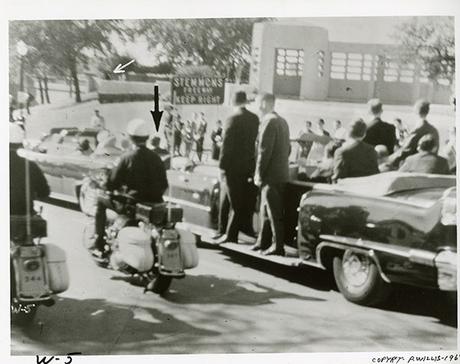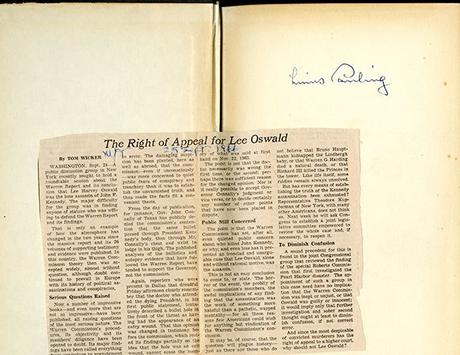Posted on by scarc
 One in a series of Kennedy motorcade photos sent to Pauling by Raymond Marcus.
One in a series of Kennedy motorcade photos sent to Pauling by Raymond Marcus.
As was detailed in our previous series of posts, Linus Pauling's relationship with President John F. Kennedy was, at times, badly strained. But despite the tensions that existed between the two, Kennedy's assassination on November 22, 1963 came as a significant shock, and led Pauling to join his wife, Ava Helen, in sending a letter of "heartfelt sympathy" to Jacqueline Kennedy on both of their behalf.
From early on however, it is clear that Pauling was very interested in the particulars of Kennedy's death, the investigation that ensued, and the suspicions that surrounded the entire affair. Indeed, a review of the materials that Pauling collected on the Kennedy assassination suggest that he might reasonably have been termed a conspiracy theorist, and that he believed that there was likely an alternative explanation for Kennedy's murder that went beyond what the government had issued.
As is well known today, just hours after Kennedy was shot, a suspect named Lee Harvey Oswald was arrested by Dallas police. After being apprehended, and while in police custody, Oswald himself was fatally wounded by Jack Ruby, a Dallas nightclub owner. Because of the high profile of the assassination and lingering questions about Oswald's role, an official investigation was commissioned. The product of that investigation, known as the Warren Report, declared that Oswald acted as a lone gunman and that he was singularly responsible for the killing.
With this, the U.S. government declared the case to be closed and, in the years since, it has not continued to investigate the assassination in any public forum. Of course, many people disputed the Warren Report's conclusions, some believing that Oswald was set up by the government and others arguing that Oswald acted with accomplices. Pauling, it seems safe to say, was among those casting doubts, if a minimally active one.
 The inside front cover of Pauling's copy of the Warren Report.
The inside front cover of Pauling's copy of the Warren Report.
One early sign that Pauling questioned the official account is scribbled in the margins of a 1964 Saturday Evening Post article written by D.C. political journalist Stewart Alsop, hypothesizing that Oswald had no connection to the CIA. In the piece, Alsop steadily builds upon this idea until, midway through, outright concluding that there was no association. Next to this paragraph, Pauling noted in his trademark loopy print, "How does Alsop know?" If nothing else, this interjection indicates that Pauling was keenly interested in the specifics of the Kennedy case and the evidence surrounding his murder.
Pauling's intrigue was such that he began to query others about the assassination. Among these correspondents was a law firm, Waldman & Lobenthal. Pauling also made note of having called Raymond Marcus, an outspoken critic of the the Warren Report. After their phone call, Marcus sent Pauling a series of photos and documents, requesting his "comments on the material," which in Marcus' view pointed towards a conspiracy.
Pauling likewise saved numerous articles that either suggested a conspiracy or highlighted perceived flaws in the Warren Report. Pauling even subscribed to the newsletter circulated by the "Assassination Inquiry Committee," a group that flatly rejected the Warren Report and sought to find a hidden truth about the Kennedy assassination.
Time moved forward and Pauling's work and life circumstances changed, but he maintained an interest in the assassination. In 1975, a dozen years after Kennedy was killed, a nonprofit organization called the Citizens Commission of Inquiry was created to
make the American people, the media, and the Congress aware of the obfuscation by the CIA, FBI, and other federal police organizations of the facts surrounding the assassination of President John F. Kennedy [...] hopefully to culminate in a Congressional investigation into the cover-up of these facts and the assassination itself.
Pauling was specifically sought out by the commission and asked to set up a team of scientists who could analyze the evidence surrounding the case. As it happened, Pauling was in Australia when the letter was sent, and by the time he returned a replacement team had been created.
Nonetheless, Pauling kept tabs on the group's continuing work. Most notably, Pauling's papers include several blank petition forms urging support for the Citizen Commission of Inquiry's mission statement. While it is unknown whether or not Pauling actually circulated the petition, a 1976 letter from Mark Lane, the group's lawyer, offers thanks to Pauling for his "encouragement" and "contributions."
From the documentary evidence, one might surmise that Pauling was only minimally involved with efforts to debunk the official explanation of Kennedy's assassination, but his interest in the topic was certainly strong. At times he seems to have provided support for various initiatives, and he consistently monitored the work of organizations that sought to demystify or debunk the findings of the Warren Report. From Pauling's papers we are not able to discern, for certain, his true beliefs about the assassination, but at minimum it is reasonable to conclude that he did not agree with the official reckoning of this pivotal moment in American history.
Filed under: Facets of Linus Pauling | Tagged: John F. Kennedy, Kennedy assassination, Linus Pauling, Warren Report |
